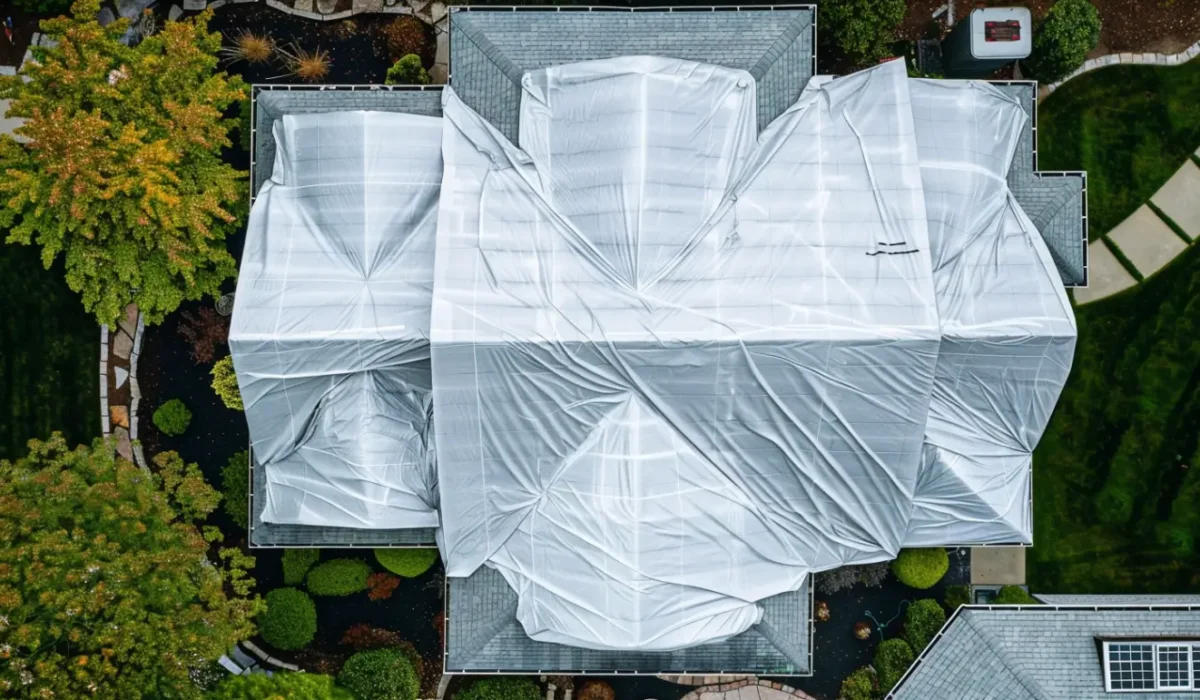Severe weather is a fact of life in Keller, TX. From heavy rains and high winds to hailstorms and flying debris, your roof often absorbs the brunt of every storm. But what happens next can make the difference between a manageable repair and a costly full replacement. If your roof has been hit by storm damage, acting quickly—and wisely—can protect your home, your investment, and your peace of mind. Here’s exactly what to do after storm damage strikes your roof.
Step 1: Ensure Safety First
Before anything else, make sure your home and family are safe. If parts of your roof have collapsed, electrical systems have been compromised, or water is entering your home, evacuate the area and contact emergency services if needed.
Avoid climbing on the roof yourself—it may be unstable, slippery, or structurally weakened. Instead, do a preliminary visual inspection from the ground. Look for:
- Missing shingles or metal panels
- Pieces of flashing or gutter on the lawn
- Sagging or punctured areas
- Debris like tree limbs on the roof
Document everything you see with clear photos from multiple angles. These images can be essential when filing an insurance claim.
Step 2: Check the Interior for Leaks and Water Damage
Next, inspect your attic and ceilings for signs of leaks. Water stains, damp insulation, bubbling paint, and moldy odors are indicators that water is getting in. Even small leaks can spread quickly if ignored.
Write down what you find and take photos inside your home as well—this documentation will help support your insurance claim and guide your roofer’s inspection.
Step 3: Schedule a Professional Roof Inspection
Even if there’s no obvious damage from the ground, it doesn’t mean your roof came out unscathed. Wind can lift shingles, hail can create punctures, and flashing may have separated at critical joints.
The best way to get an accurate assessment is to schedule a professional roof inspection. In Keller, TX, homeowners trust KangaRoof for fast, honest, and thorough post-storm evaluations. As an OC Preferred and Emerald Premium Contractor, KangaRoof understands the unique weather conditions of the region and knows exactly what to look for after a storm.
Step 4: Mitigate Further Damage
If your roof is actively leaking or has visible holes, take immediate steps to prevent additional damage to your home. This may include:
- Placing buckets or tarps inside to catch water
- Using a temporary roof tarp to cover exposed areas (only if it’s safe)
- Removing valuables from affected rooms
Many insurance policies require homeowners to take “reasonable steps” to minimize further damage. Keep receipts for any temporary fixes you purchase, as these may be reimbursable.
Step 5: File Your Insurance Claim
Once you’ve confirmed damage through an inspection, it’s time to notify your insurance provider. File your claim as soon as possible—most policies have deadlines for reporting storm damage.
Be ready to provide:
- The date and time of the storm
- Photos of exterior and interior damage
- Your roofing contractor’s inspection report
- Details about any emergency repairs you made
Having a reputable roofer like KangaRoof by your side during this process can be invaluable. They can speak directly with the insurance adjuster, help ensure accurate documentation, and advocate for a fair assessment.
Step 6: Meet With the Insurance Adjuster
Your insurance company will assign an adjuster to evaluate the damage and determine what will be covered. It’s a smart move to have your roofer present during the adjuster’s visit. This ensures that all damages—especially less obvious ones—are pointed out and properly recorded.
Your contractor can also answer technical questions and help clarify the scope of work needed for full repair or replacement.
Step 7: Approve the Work and Start Repairs
After your claim is approved, you’ll receive a scope of work and payment estimate. Choose a certified contractor with proven experience, transparent pricing, and strong local references.
Avoid storm chasers offering cheap repairs—they often disappear once the job is done (or half done). Stick with trusted companies like KangaRoof that are invested in the Keller community and stand behind their work long after the last shingle is nailed down.
Final Thoughts: Act Fast, Choose Smart
Storm damage to your roof isn’t just a cosmetic issue—it can impact your entire home’s structural integrity. Knowing what to do in the hours and days after a storm can help you avoid stress, protect your property, and save money on repairs.
In Keller, TX, where storm damage is a real and regular threat, having a reliable plan and a roofing partner you trust can make all the difference.
Read also our blog: How to File a Roof Insurance Claim After a Storm
